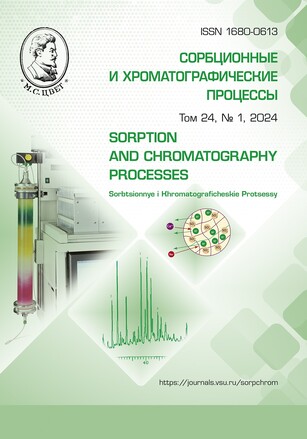Sorption of divalent metal ions from aqueous solutions on activated carbon with its further separation through electroflotation
Abstract
Currently, there are multiple methods for wastewater treatment from metal ions. One of the leading methods is the sorption process. The advantage of sorption purification is its ability to extract substances from multi-component mixtures and its high efficiency with low concentrations of wastewater contamination.
The purpose of this work was to study the sorption capacity of the “OU-B” activated carbon in relation to metal ions (Cu2+, Zn2+, Mn2+). The following tasks were set: establishing optimal parameters for sorption in a static mode, approximating the obtained data by linear forms of kinetic and adsorption equations, as well as obtaining the ability to separate coal particles from aqueous solutions by electroflotation.
To study the patterns, we used the following research methods: low-temperature nitrogen adsorption, atomic absorption spectrometry, and nephelometry.
The optimal parameters for sorption in a static mode (sample size of coal, process time, initial concentration of metal ions) were established experimentally. The maximum degree of extraction of metal ions in the course of sorption was achieved with a 1:133 ratio of coal to aqueous solution during 60 minutes and was 82% for Cu2+, 73% for Zn2+, and 63% for Mn2+.
The obtained sorption results were analysed using the kinetic models of Zeldovich-Chen-Clayton of pseudo-first and pseudo-second order and adsorption models of Langmuir, Freundlich, Temkin, Dubinin-Radushkevich, and Flory-Higgins. The analysis showed that the sorption of Cu2+, Zn2+, and Mn2+ on OU-B carbon occurred according to the mechanism of physical adsorption, which was described by the sorption models of Langmuir and Freundlich and the Zeldovich-Chen-Clayton kinetic model.
The separation of used sorbents and the aqueous phase was a difficult task from a technological point of view due to the small size of carbon particles. The article showed the prospects of using electroflotation for extracting OU-B carbon from aqueous solutions: the degree of extraction of coal particles reached 97-99% when cationic or non-ionic SAS were added to the solution.
Downloads
References
Connor R. The United Nations world water development report 2015: water for a sustainable world. France, UNESCO publishing, 2015; 1: 139.
Radhakrishnan K., Sethuramana L., Panjanathana R., Natarajana A., Solaiappanb V., Thilagaraja W.R. Biosorption of heavy metals from actual electroplating wastewater using encapsulated Moringa oleifera beads in fixed bed column. Desalination and Water Treat-ment. 2016; 57(8): 3572-3587.
Chirkst D.Je., Cheremisina O.V., Ivanov M.V., Chistjakov A.A., Zhadovskij I.T. Issledovanie kinetiki sorbcii kationov nikelja piroljuzitsoderzhashhim sorbentom. Zapiski Gornogo instituta. 2006; 169: 213-218. (In Russ.)
Kaljukova E.N. Kolichestvennye harakteristiki processa sorbcii kationov nikelja (II) i marganca (II) na prirodnom sorbente opoke. Bashkirskij himicheskij zhurnal. 2009; 16(3): 54-58. (In Russ.)
Kac Je.M. Kinetika sorbcii tjazhelyh metallov iz poverhnostnoj vody na prirodnom i modificirovannom polijetileniminom klinoptito-lite Holinskogo mestorozhdenija. Sorbtsionnye i khromatograficheskie protsessy. 2016; 16(1): 36-43. (In Russ.)
Akpomie K.G., Dawodu F.A. Efficient abstraction of nickel (II) and manganese (II) ions from solution onto an alkaline-modified montmorillonite. Journal of Taibah University for Science. 2014; 8(4): 343-356.
Kurdjumov V.R., Timofeev K.L., Mal'cev G.I., Lebed' A.B. Sorbcionnoe izvlechenie ionov nikelja (II) i marganca (II) iz vodnyh rastvorov. Zapiski gornogo instituta. 2020; 242: 209-217. (In Russ.)
Ryabinina E.I., Zotova E.E., Ponomare-va N.I., Andreeva N.A. Sorption activity of apple pulp in relation to zinc, copper and nickel ions. Applied information aspects of medicine. 2015; 18(2): 78-82.
Linnikov O.D., Rodina I.V., Baklanova I.V., Suntsov A.Yu. Sorption of ions Cu(II) by activated carbon BAU-A. Sorbtsionnye I khro-matograficheskie protsessy. 2018; 18(4): 554-562. (In Russ.)
Ivanec M.G., Grinshpan D.D., Cygankova N.G., Nevar T.N., Makarevich S.E. Ochistka stochnyh vod razlichnogo sostava modificirovannymi ugol'nymi sorbentami. Vescі nacyjanal'naj akadjemіі navuk belarusі. Seryja hіmіchnyh navuk. 2011; 3: 70-75. (In Russ.)
Gaydukova A.M., Pokhvalitova A.A., Kon’kova T.V., Stoyanova A.D. The effect of salinity on the efficiency of wastewater treat-ment from iron (III) ions by electroflotosorption method. ChemChemTech. 2022; 65(12): 119-125.
Bjankina L.S., Vas'kova N.A., Hal'chenko I.G. Primenenie jelektrohimicheskogo metoda i modificirovannyh sorbentov dlja nejtralizacii himicheskogo zagrjaznenija stochnyh vod gal'vanicheskogo proizvodstva. Nauchnye trudy Dal'rybvtuza. 2011; 24: 20-24. (In Russ.)
Pokhvalitova A.A., Gaidukova A.M. Improving the efficiency of the electroflotation process of extracting the powder sorbent «OU-A» from a solution of sodium nitrate with the addition of flocculants. Advances in chemistry and chemical technology. 2021; 35(6): 141-143.
Milutina A.D., Gavrilova N.N., Kolesni-kov V.A., Desyatov A.V. The influence of sur-factants and hydroxides of nickel (II) and co-balt (II) on the efficiency of electroflotation extraction of carbon nanomaterials from aque-ous solution. Water: Chemistry and Biology. 2017; 9: 78-83.
Gavrilova N.N., Nazarov V.V. Analiz poristoj struktury na osnove adsorbcionnyh dannyh: ucheb. posobie. Moskva, RHTU im. D. I. Mendeleeva, 2015, 132 p. (In Russ.)
Ali I., Kon'kova T., Kasianov V., Rysev A., Panglisch S., Mbianda X.Y., Habila M.A., Al Masoud N. Preparation and characterization of nano-structured modified montmorillonite for dioxidine antibacterial drug removal in wa-ter. Journal of Molecular Liquids. 2021; 331: 115770.
Kolesnikov A.V., Milyutina A.D., Desyatov A.V., Kolesnikov V.A. Electroflota-tion recovery of highly dispersed carbon mate-rials from aqueous solutions of electrolyte. Separation and Purification Technology. 2019; 209: 73-78.
Kolesnikov V.A., Gaidukova A.M., Kolesnikov A.V., Gubin A.F., Vetlugin N.A. Electroflotation extraction of sparingly soluble rare-earth compounds in a multicomponent mixture from aqueous solutions containing chloride ions. Theoretical Foundations of Chemical Engineering. 2020; 54(5): 856-862.
Meshalkin V.P., Kolesnikov V.A., Desyatov A.V., Milyutina A.D., Kolesnikov A.V. Physicochemical efficiency of electroflo-tation of finely divided carbon nanomaterial from aqueous solutions containing surfactants. Doklady Chemistry. 2017; 476(1): 219-222.







